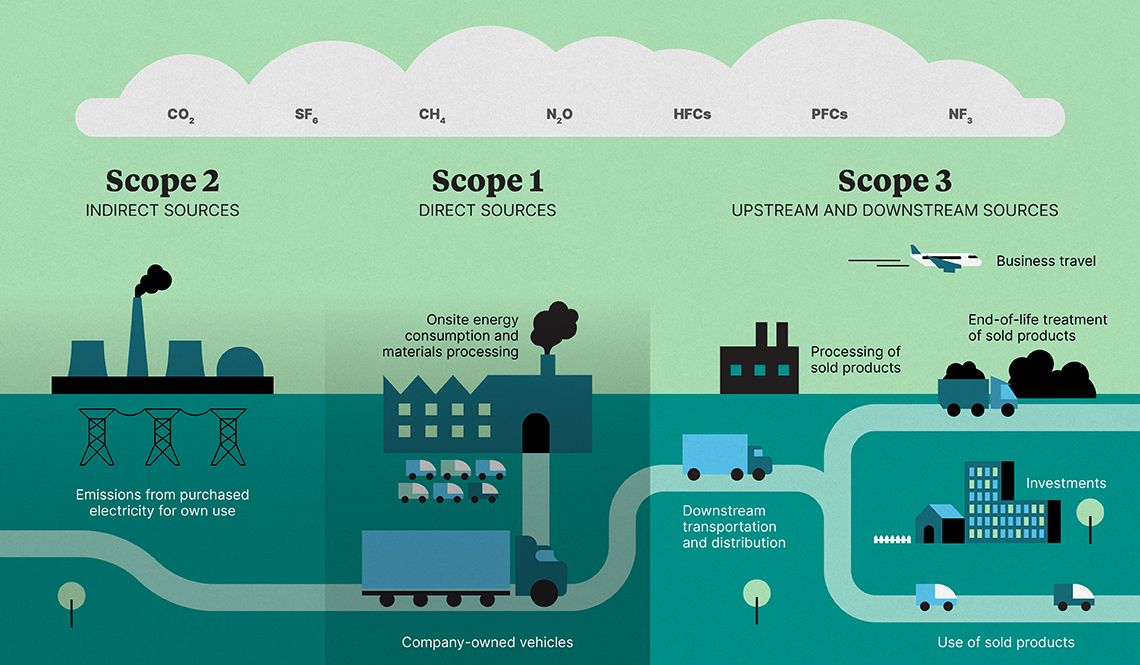Here's how Scopes are defined, when it comes to measuring greenhouse gases.
Organisational and operational boundaries are fundamental concepts that outline key characteristics of any GHG inventory. They help both internal and external stakeholders in addressing important queries related to corporate GHG emissions tracking.
The Scopes Framework
- Helps companies understand the extent of control they have over GHG emissions, highlighting areas where their influence may be limited
- Increases visibility of GHG emissions so they can develop strategies tailored for emission reduction across the entire value chain
- Establishes a comprehensive GHG accounting strategy to mitigate the risk of overlooked emission sources or operations
What does it cover?
GHG emissions are categorised into three scopes: Scope 1 are direct emissions sources that are owned or controlled by a company, whereas scope 2 and 3 indirect emissions are a consequence of the activities of the company but occur from sources not owned or controlled by it.
This diagram illustrates how these sources play a role in the value chain of a business.

While it might be challenging to track Scope 3 emissions as it requires a lot more data from a company’s clients and suppliers, it is crucial to measure this scope as it makes up 65–95% of most companies' carbon impact.
In this figure, it is evident that Scope 3 needs to be addressed in a company’s GHG accounting.

Scope 1: Direct Emissions
Scope 1 emissions refer to direct GHG emissions produced from sources that are owned or controlled by a company. This includes emissions from on-site combustion of fuels, industrial processes, and transportation of owned or controlled vehicles. They are considered the most direct and immediate responsibility of the organisation.
Direct GHG emissions are principally the result of the following types of activities:
-
Generation of electricity, heat, or steam through the combustion of fuels.
-
Manufacturing or chemical processing of chemicals and materials.
-
Transportation of materials, products, waste, and employees in company-owned or controlled mobile combustion sources.
-
Fugitive emissions resulting from intentional or unintentional releases of refrigerant gases within air conditioning, (e.g. equipment leaks, hydrofluorocarbon emissions during the use of refrigeration).
Some ways to reduce Scope 1 emissions
- Reducing energy consumption in facilities and buildings: Unplug appliances and power down computers and other electronic equipment at night. Run fans to keep air flowing throughout the space to help HVAC systems run more efficiently.
- Increasing energy efficiency: Adding or replacing insulation can help prevent energy loss and significantly reduce emissions
- Installing energy efficient appliances: Energy label ratings are given to products that meet energy efficiency standards, and can help organisations make better decisions about the appliances they use in their premises
Scope 2: Indirect emissions (purchased power)
Scope 2 emissions represent indirect GHG emissions associated with the generation of purchased electricity, heat, or steam consumed by an organisation. These emissions are generated off-site, rather than the organisation's own facilities.
Though indirect, Scope 2 emissions are still under the organisation's control through purchasing decisions. For example, purchased electricity represents one of the largest sources of GHG emissions and the most significant opportunity to reduce Scope 2 emissions.
Companies can usually calculate scope 2 emissions based on the consumption outlined in their energy bills. Accounting for these emissions allows them to assess the risks and opportunities associated with changing electricity and GHG emissions costs.
Some ways to reduce Scope 2 emissions
- Investing efficient equipment and infrastructure
- Switching to renewable electricity: Emerging green power markets provide opportunities for some companies to switch to less GHG-intensive sources of electricity
- Installing an efficient on-site co-generation plant: Particularly if it replaces the purchase of more GHG-intensive electricity from the grid or electricity supplier
Scope 3: Indirect emissions (upstream and downstream)
Scope 3 emissions refer to indirect GHG emissions that occur throughout an organisation's value chain, including both upstream and downstream activities. These emissions result from activities such as purchased goods and services, transportation and distribution, waste disposal, and use of products.Some ways to reduce Scope 3 emissions
- Collecting and reporting data on your Scope 3 emissions: With this data they can identify hotspots and develop strategies to reduce GHG emissions
- Providing incentives and guidance to suppliers to support their decarbonisation journey: Work with suppliers to help them adapt more sustainable production practices
- Making products and packaging recyclable whenever possible: Recycling helps reduce GHG emissions by reducing energy consumption and the amount of waste decaying in landfills
- Writing refreshed policies on business travel: Business travel is a significant contributor to emissions and usually avoidable
We dive deeper into Scope 3 emissions with this article, Managing Scope 3 Emissions.
Beyond the Scopes: Biogenic CO2 emissions
Biogenic CO2 refers to CO2 emissions from biological origins (e.g. biofuel combustion, biogas production) as opposed to CO2 emissions from fossil fuels. Biogenic CO2 emissions are often referred as ‘short-cycle’ carbon. As such, they fall outside of the established scopes.
However, as companies turn to biogenic alternatives in their operations, biogenic CO2 emissions have increased over the years and can potentially hinder progress toward net-zero goals.




